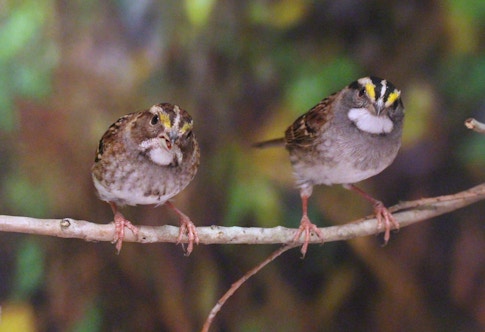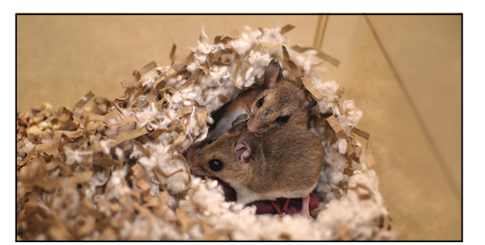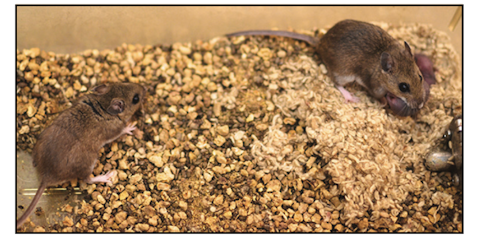The Social Lives of Birds and Mice: A Lens into the Nature of Emotion

Humans are fascinated by social interactions. Indeed, we devote much of our energy and time to our relationships, through love, conflict or caring for our children. For many animal species, social lives are also important. But the ways in which different species make and maintain relationships vary widely. And scientists still know very little about how social experiences are integrated with emotions in the brain. To gain a deeper understanding of this process, Jennifer Merritt, a Junior Fellow with the Simons Society of Fellows, employs insights from evolutionary science.
Merritt earned a doctorate in neuroscience and animal behavior at Emory University and is now a postdoctoral fellow in the lab of Andrés Bendesky at Columbia University’s Zuckerman Institute. Our conversation has been edited for clarity.
What piqued your interest in the science of social behavior?
From an early age, I saw that mental illness and addiction not only affect that individual, but also their relationships with others. I originally wanted to understand the underlying neural processes that lead to these debilitating diseases, but I was surprised to find that we know little about how emotions are encoded in the brain. In many cases, treatments for psychiatric disorders have remained largely unchanged for decades, even though many of those treatments only work for a subset of patients and can come with harmful side effects. There is a real need to understand, on a very basic level, how and why animals choose to interact with others around them. While my current research is removed from therapeutic practice, the work I do contributes to a stronger foundational understanding of brain science.
What kind of behavior do you study?
I focus on the evolution of ‘innate’ behaviors in animals. These are behaviors that we don’t have to teach the animal, such as mating, defensive behavior and care for offspring. All animals exhibit these behaviors to varying degrees. Genetics may hold the key to understanding why the behavior of related animals that one would think should be similar is actually very different.
It’s interesting: If we look carefully, we can find animals that are very closely related, with only a few genetic differences, but have very different social lives. These differences make for great ‘natural experiments’ in which we can observe that just a few genetic differences are causing vastly divergent social and behavioral outcomes.
Your doctoral research at Emory focused on the white-throated sparrow. What makes these birds so interesting?
White-throated sparrows are a species of songbird that is common to North America with a very uncommon social structure! Half of these sparrows have white stripes on their head, with the other half displaying tan stripes. The white-striped type, or ‘morph,’ spends more time defending their territory. The tan-striped morph, meanwhile, spends more time nurturing their offspring. Remarkably, these two morphs always mate with each other. Here, opposites really do attract.
Up until the 1960s, naturalists like John Audubon assumed that these two morphs represented a male and female. More recently, experts discovered that the morphs were not sex-specific; both males and females could exhibit white or tan stripes. This means that each individual sparrow must find a mate not only of the opposite sex, but also of the opposite stripe color. This has earned white-throated sparrows the nickname ‘the bird with four sexes.’
In addition to this behavioral quirk, the genetic differences between these two morphs are also interesting. The white-striped morphs have what is known as a supergene: a stretch of many genes on a chromosome that are inherited as a single block, without any of the intermingling with other genes you normally see during fertilization. This is not unlike how the Y chromosome is passed down unchanged. Determining which of these genes in that supergene contribute to the bird’s behavior, and which are just along for the ride, is a huge area of focus, and a challenging one.

What have you discovered about the genes involved in the white-throated sparrow behavior?
During my doctoral research I built on foundational studies showing that the level of an animal’s steroid hormones can shift its motivation to be either more aggressive or more parental. I therefore reasoned that these hormones were probably involved in the observed differences between the white-striped and tan-striped morphs. I discovered that a gene called ESR1, which makes estrogen receptors, is in the supergene I mentioned previously. The supergene version of ESR1 is mutated, so white-striped morphs have more estrogen receptors in the amygdala, the part of the brain that integrates social information with emotions, as compared to their tan-striped counterparts. When I got rid of estrogen receptors in the amygdala, the birds were less aggressive.
This work, published in the Proceedings of the National Academy of Sciences, gave us a point of entry into understanding this supergene and its impact on behavior. It has enabled us to ask more questions about how changes in the genome can shift the sensitivity of the brain to social interactions.
Your research indicates that estrogen is involved in aggression. Wouldn’t testosterone also have an effect?
There’s this notion that testosterone is the sole hormone for aggression. But actually, a lot of testosterone is converted into estrogen locally in the brain. The brain also can make its own estrogen.
It’s also important to remember that all animals — both male and female — have both testosterone and estrogen, just at different levels. In effect, estrogen is part of the aggression trigger in both males and females.
What are you focusing on now, during your postdoc?
I came to the Bendesky lab to better understand the neurobiology of monogamy: how long-term social relationships are formed and maintained. Only about 5 percent of mammals are monogamous, including some humans. However, our standard lab animals, such as mice, rats and fruit flies, are not. Understanding how monogamy evolves requires studying an organism that forms these relationships in a consistent manner.


So, I turned to deer mice, one particular species of which, Peromyscus polionotus, is monogamous. Male and female members of these species become socially attached after mating, and when they have offspring, the males assume an active parental role. Meanwhile its sister species, Peromyscus maniculatus, exhibits the more common rodent behavior in which interactions between adult males and females are transient, with only the females caring for their young.
The real difference between these two deer mice species appears to be the fathers. I want to know if males of each species use the same brain regions as the mother to care for the young, or if the father has evolved a new system to care for their offspring. Another possibility is that there’s only one parental brain circuit that can be used by both sexes under the right circumstances. That’s our work in progress.
How are you studying monogamy in deer mice?
I am looking for markers of active neurons in many brain regions at specific time points, such as after the animal interacts with their mate or offspring. I also watch the animals’ neural activity in real time using a technique called fiber photometry, in which we use a fiber-optic cable to measure the neural activity with florescent light. This lets us see which neurons fire and which don’t, while the paternal male mice are engaging with their offspring or their mate. From that, we can eventually manipulate those neurons to determine their role in these behaviors. I’m just getting started, but I take real joy in performing these experiments, even when my hypotheses are wrong! Science is about keeping an open mind to what you discover and not being wedded to what you thought before.
Finally, what are your thoughts about the Simons Junior Fellowship?
I love being part of the Simons Foundation. The in-person weekly dinners are awesome. Interacting with experts in completely different fields is thought-provoking and helps me think more creatively about my own research.
On top of being extremely intellectually engaging, the Junior Fellowship provides a strong community for all of us. Usually, postdoctoral fellows enter a lab by themselves, not with a cohort like in graduate school, so it can sometimes be lonely. We Junior Fellows have a real sense of belonging; I think of them as my postdoc cohort. I’m very grateful to be part of this community.